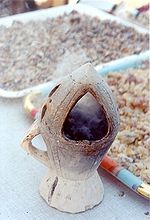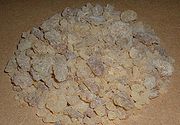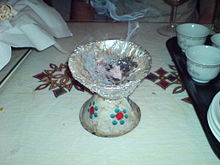- Dabqaad
-
The dabqaad (Somali for "fire raiser"), also known as idin or girgire, is an incense burner, or censer. With either one or two handles, it is commonly used in Somalia, Djibouti, Ethiopia and Eritrea.
Contents
Usage and production
Dabqaads are traditionally used to perfume homes after large meals and/or during special occasions, such as when one is expecting guests.
Frankincense (lubaan) or a prepared incense (cuunsi), which in countries in the Arabian Peninsula is known as bukhoor, is placed on top of hot charcoal inside an incense burner, the dabqaad. It then burns for about ten minutes. This keeps the house fragrant for hours.
The dabqaad pot is made from a white clay or soapstone found in specific areas of both southern and northern Somalia. Meerschaum (sepiolite) is used to make the dabqaad, with the district of El Buur serving as a center for quarrying. El Buur is also the place of origin of the local pipe-making industry.[1]
Somalis living in the West obtain their dabqaads from visits to the Horn of Africa or they have relatives residing in the region send them.
Variants
Variants of the dabqaad incense burner are lit after meals in Eritrea and Ethiopia, often in conjunction with traditional coffee ceremonies. One hand-held variety referred to as the maetant that is suspended by means of three or sometimes four chains is also used in virtually every Ethiopian Orthodox Church service.[2]
The dabqaad is closely related to the Arabian mabkhara, albeit generally less elaborately decorated. The mabkhara is widely used amongst Arab communities living in the West and throughout the Middle East (excluding Israel) and North Africa.
See also
Notes
References
- Abdullahi, Mohamed Diriye (2001). Culture and customs of Somalia. Greenwood. ISBN 9780313313332. http://books.google.com/books?id=2Nu918tYMB8C.
Categories:- Somalian culture
Wikimedia Foundation. 2010.



